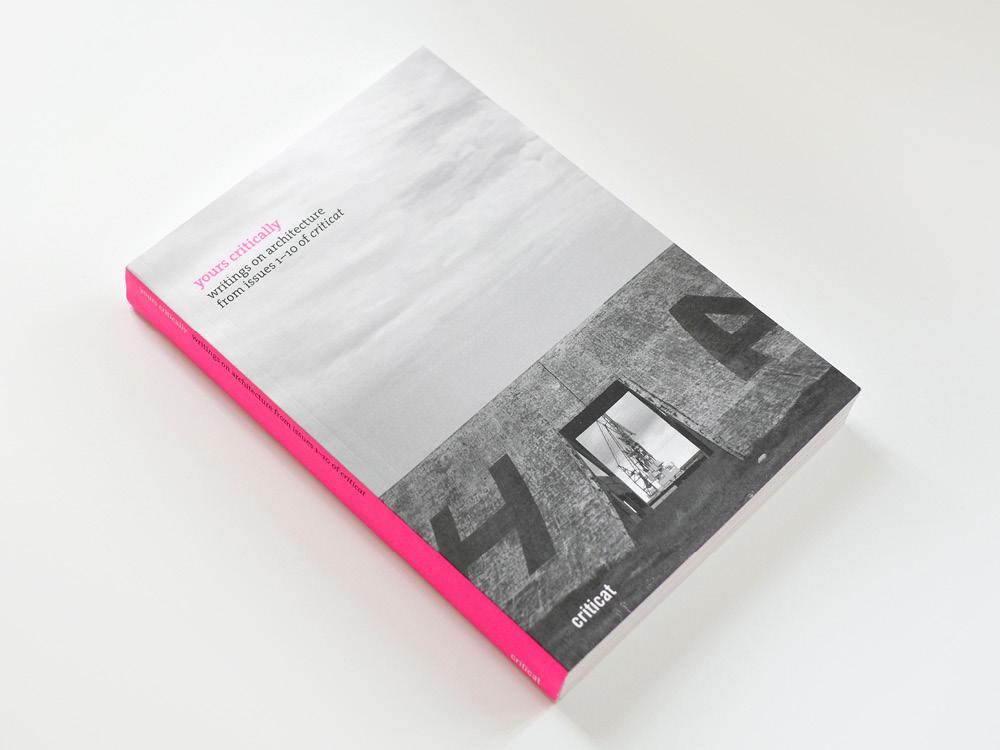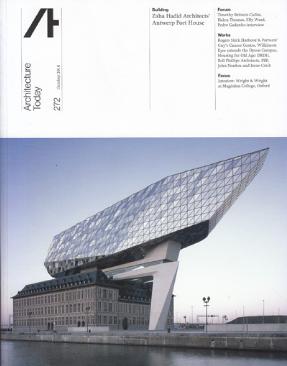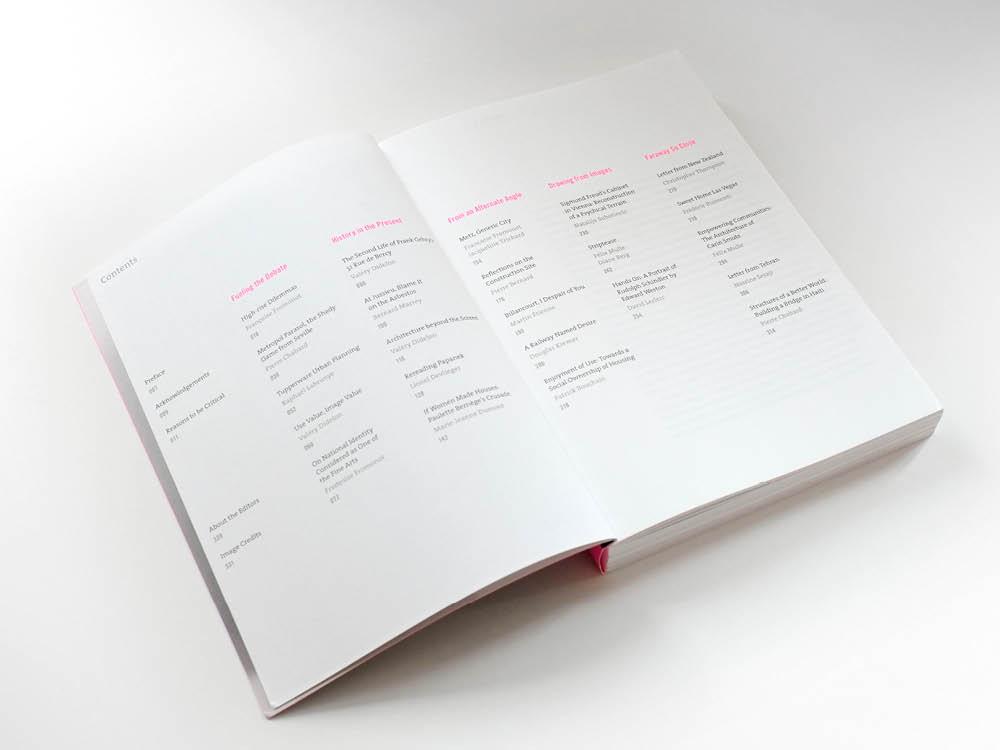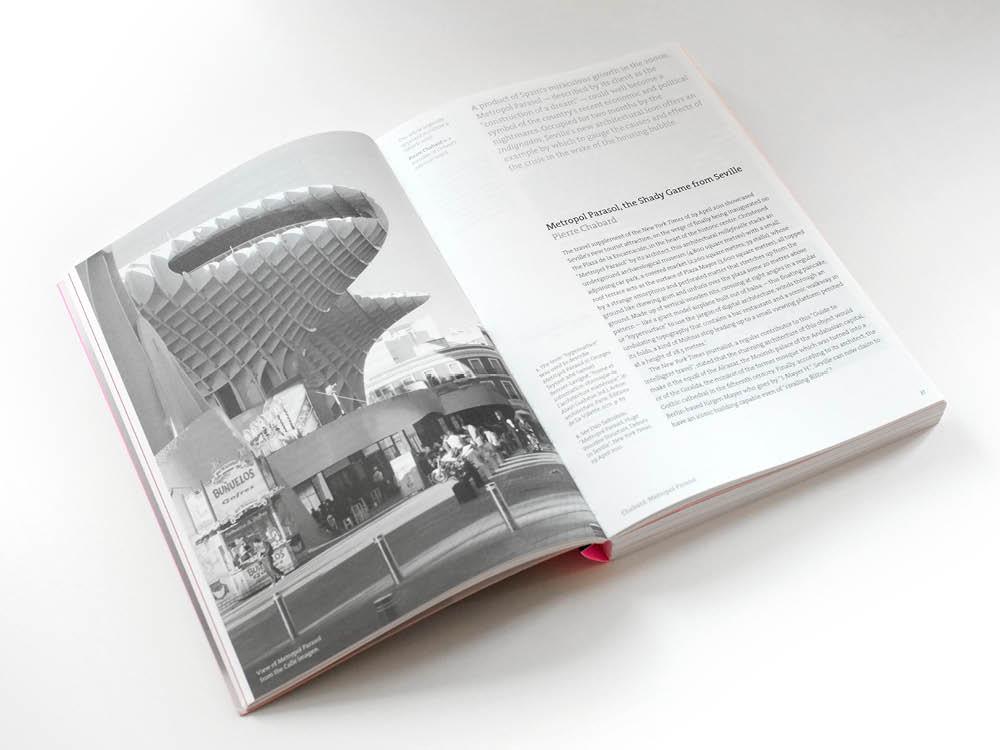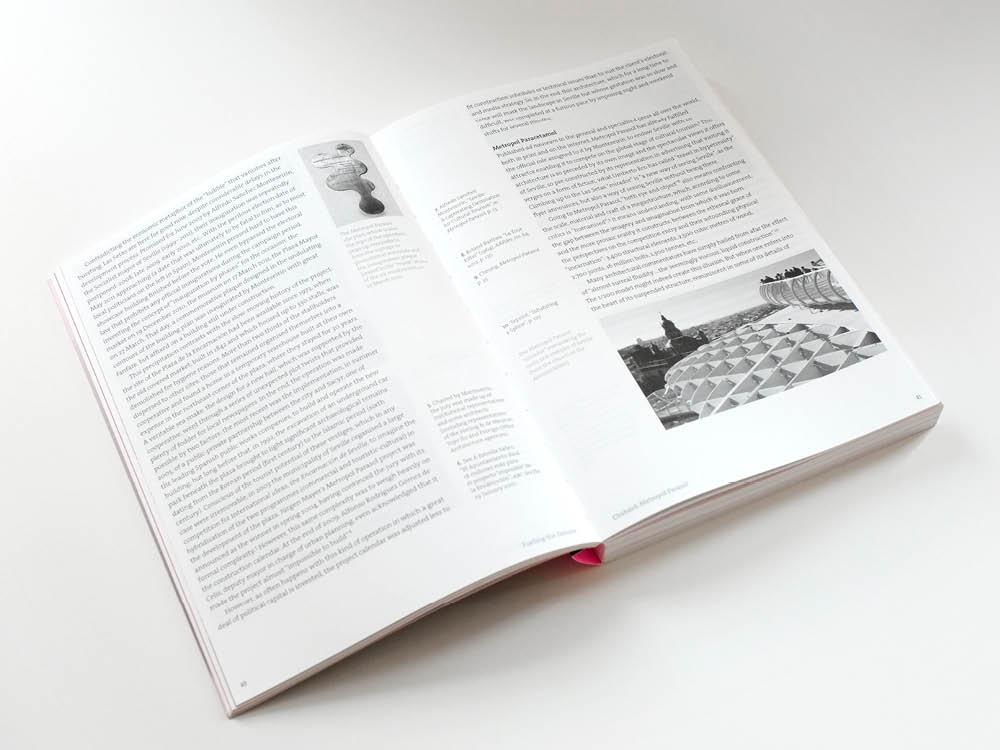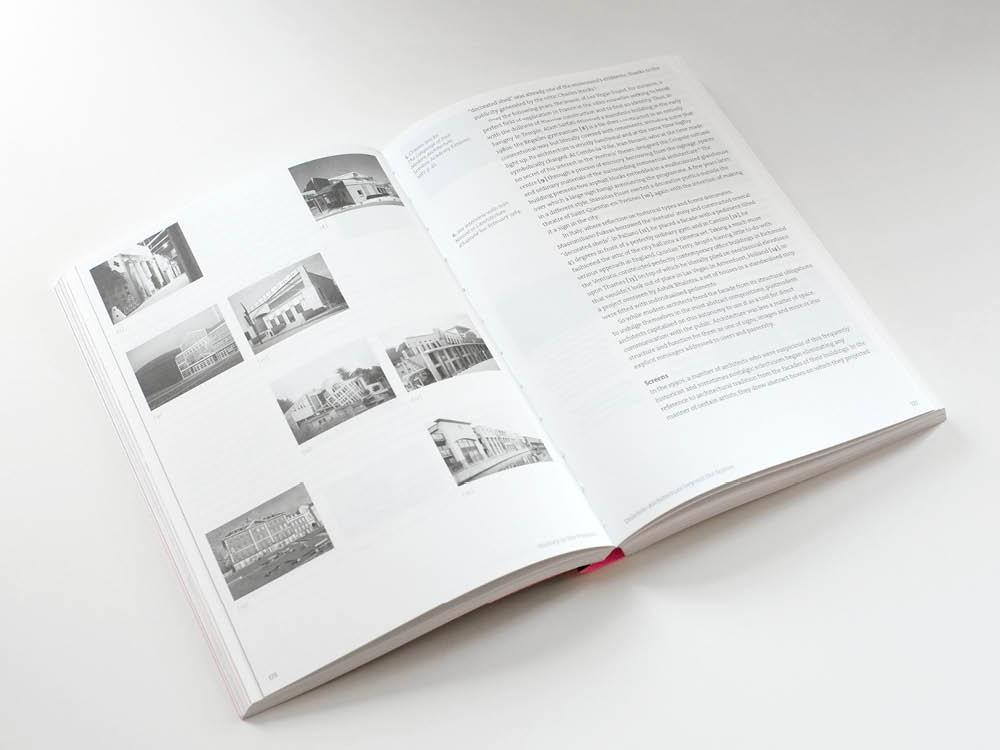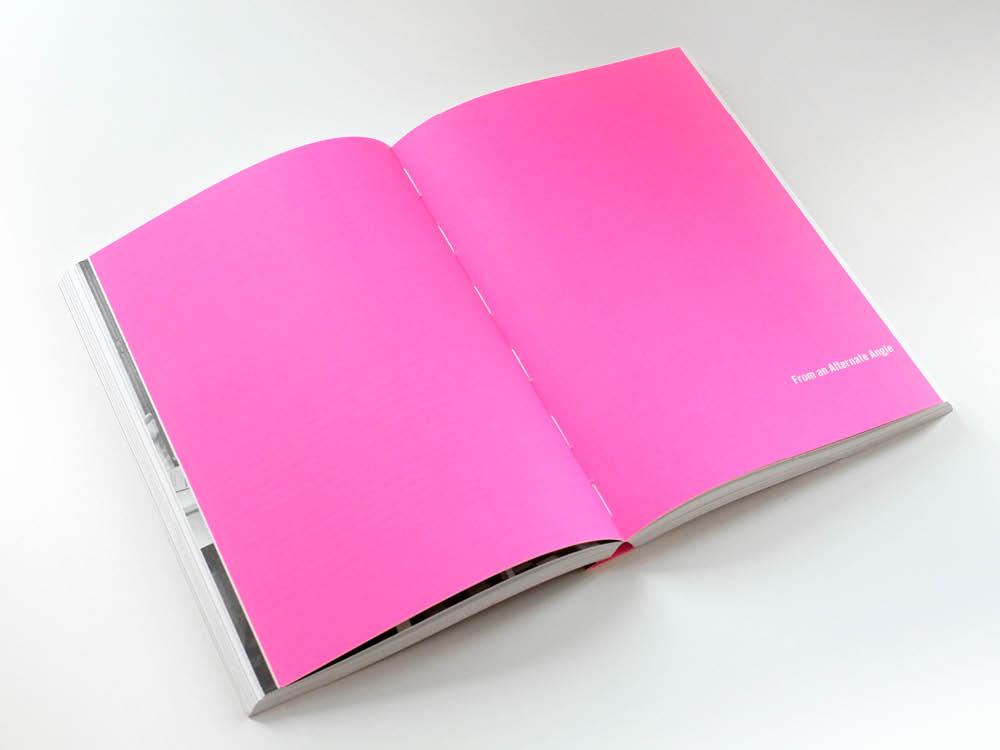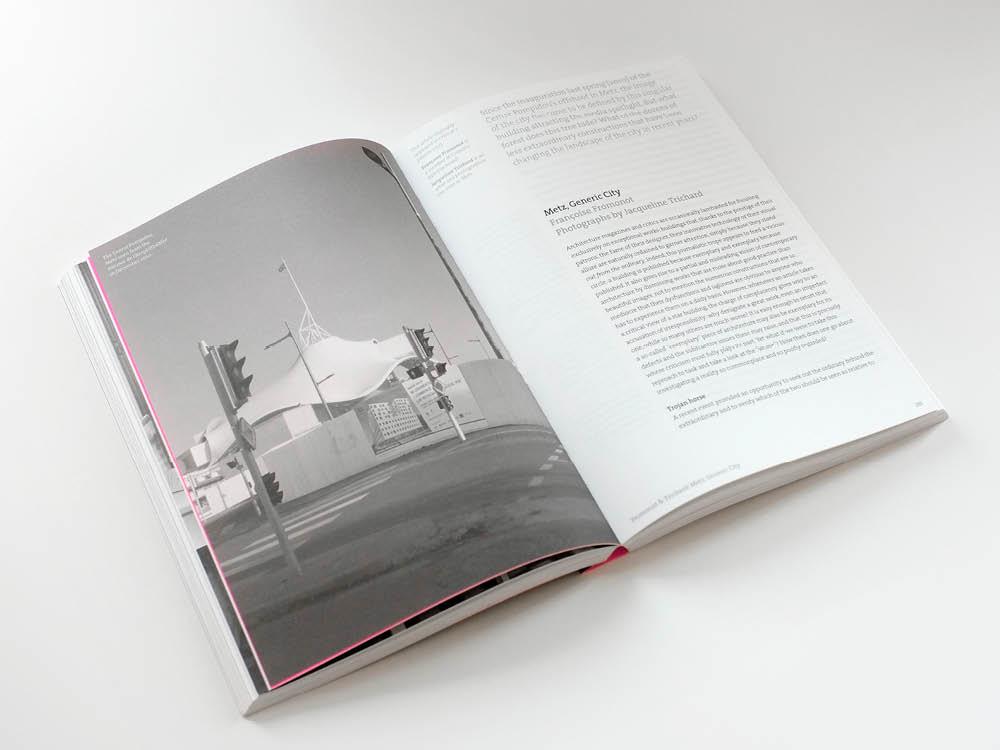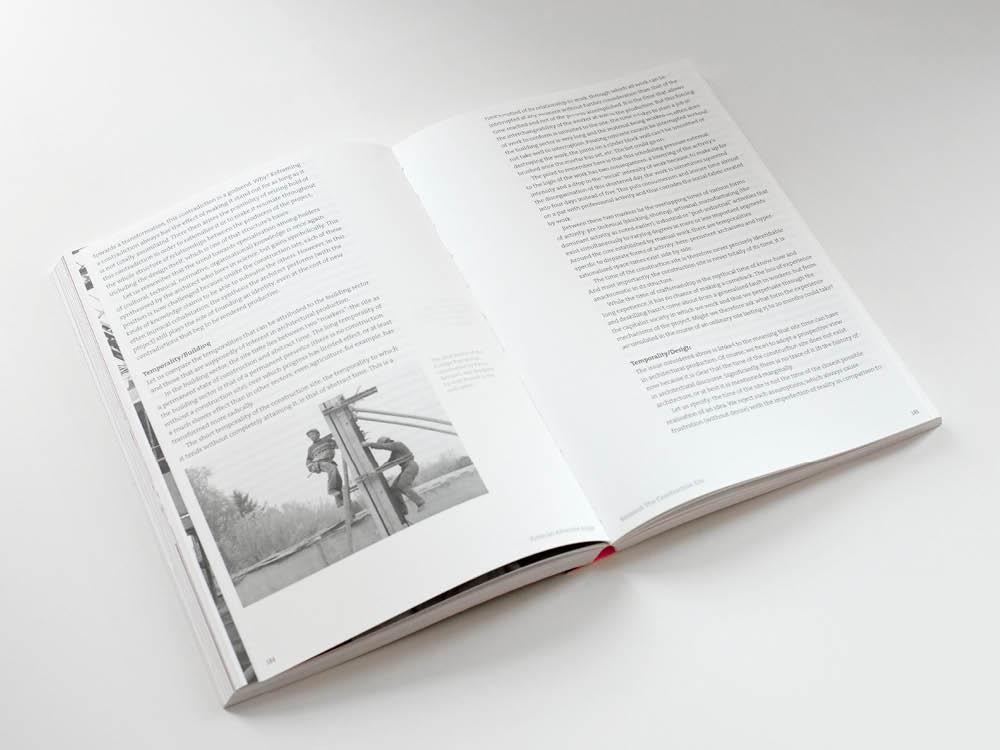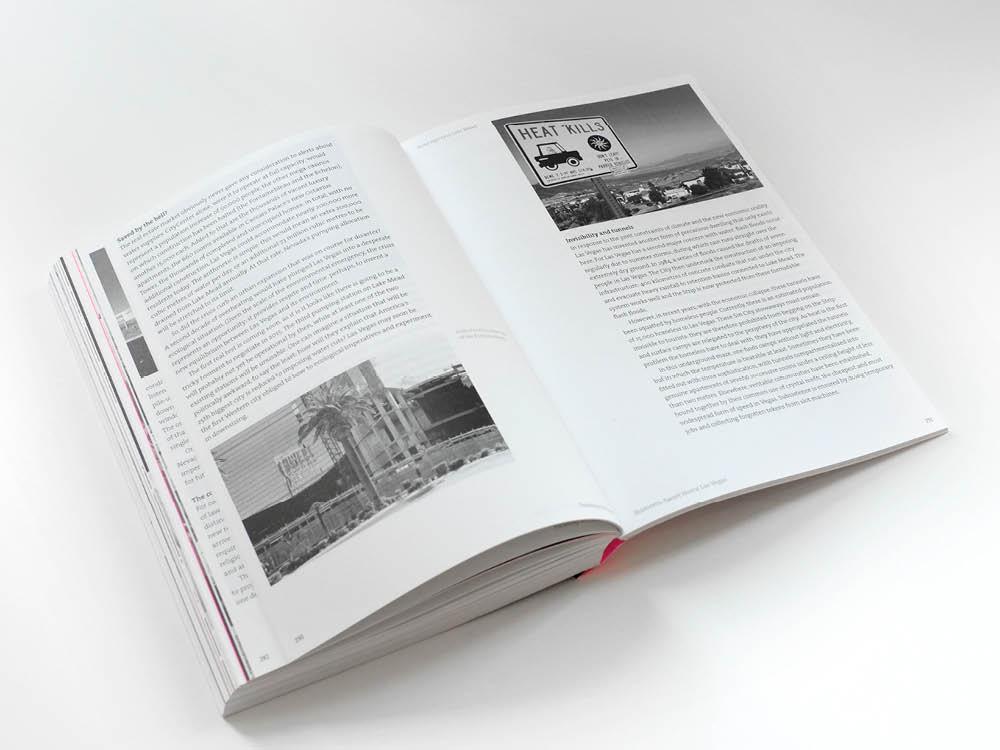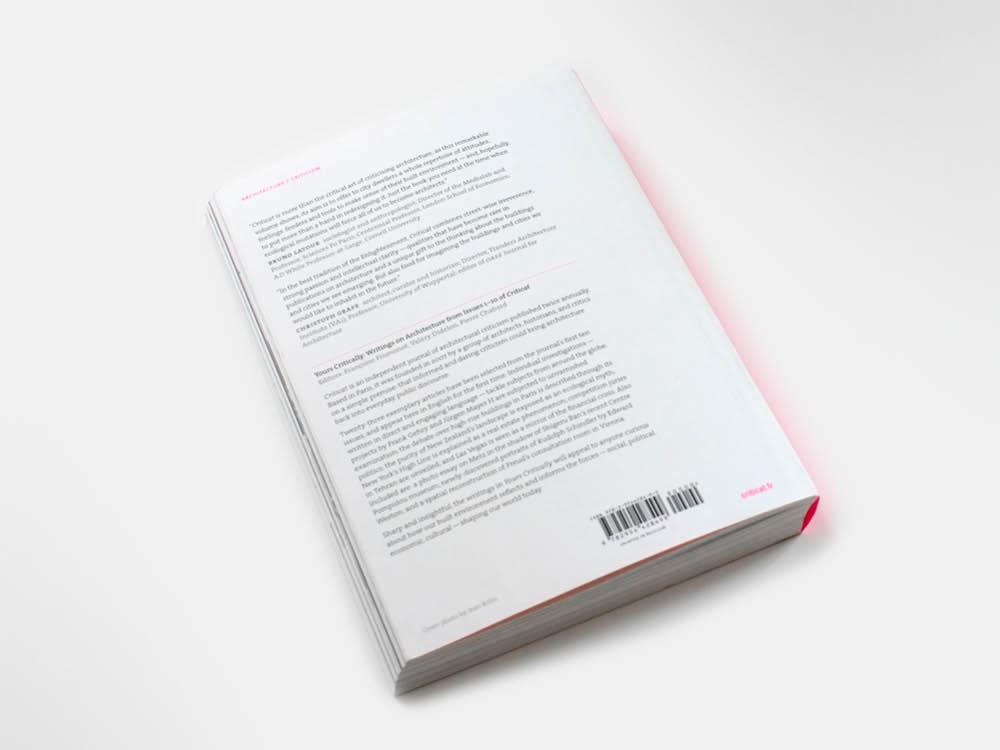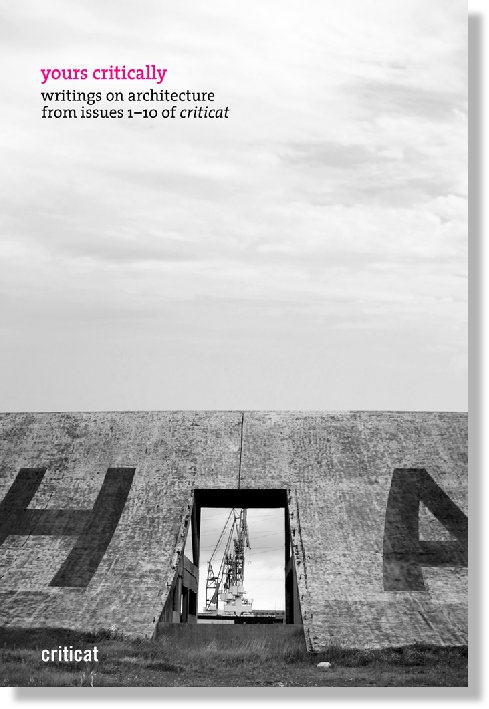Editors: Françoise Fromonot, Valéry Didelon, Pierre Chabard
Paperback
332 pages
16 × 23.5 cm
330 illustrations
Published by Criticat, Paris
May 2016
ISBN
9782954428499
Yours Critically is no longer in wide distribution.
It remains available for sale from some online vendors and local bookstores. If you are a critic,
journalist, or university faculty member interested in acquiring a review copy, please contact Françoise Fromonot.
Read it online here
Publication Overview
Criticat is an independent journal of architectural criticism published twice annually. Based in Paris, it was founded in 2007 by a group of architects, historians, and critics on a simple premise: that informed and daring criticism could bring architecture back into everyday public discourse.
Twenty-three exemplary articles have been selected from the journal’s first ten issues, and appear here in English for the first time. Individual investigations — written in direct and engaging language — tackle subjects from around the globe.
Sharp and insightful, the writings in Yours Critically will
appeal to anyone curious about how our built environment reflects and informs the forces — social,
political, economic, cultural — shaping our world today.
Endorsements
“Criticat is more than the critical art of criticising architecture: as this remarkable volume shows, its aim is to offer to city dwellers a whole repertoire of attitudes, feelings, feeders and tools to make sense of their built environment — and, hopefully, to put more than a hand in redesigning it. Just the book you need at the time when ecological mutations will force all of us to become architects.”
Bruno Latour sociologist and anthropologist; Director of the Médialab and Professor, Sciences Po Paris; Centennial Professor, London School of Economics; A D White Professor-at-Large, Cornell University
“In the best tradition of the Enlightenment, Criticat combines street-wise irreverence, strong passion and intellectual clarity — qualities that have become rare in publications on architecture and a unique gift to the thinking about the buildings and cities we see emerging. But also food for imagining the buildings and cities we would like to inhabit in the future.”
Christoph Grafe architect, curator and historian;
Director, Flanders Architecture Institute (VAi); Professor, University of Wuppertal; editor of OASE Journal for Architecture
Contents
Preface
Acknowledgements
Reasons to be Critical
Fueling the Debate
High-rise Dilemmas
Françoise Fromonot
For the past five years [2003 – 2008], the City Council has periodically revived the idea of allowing the construction of new high-rise buildings in central Paris. Search for a magic potion? Throwback to the good old modernist remedy? Or just a spectacular example of the municipal government’s inability to envision the future of the capital and its suburbs?
Françoise Fromonot is a member of Criticat’s editorial board. Her book La Campagne des Halles (Paris, 2005) is a critical account of the 2002–2004 urban competition for the renovation of central Paris.
This article originally appeared in Criticat 1 (January 2008).
Metropol Parasol, the Shady Game from Seville
Pierre Chabard
A product of Spain’s miraculous growth in the 2000s, Metropol Parasol — described by its client as the “construction of a dream” — could well become a symbol of the country’s recent economic and political nightmares. Occupied for two months by the Indignados, Seville’s new architectural icon offers an example by which to gauge the causes and effects of the crisis in the wake of the housing bubble.
Pierre Chabard is a member of Criticat’s editorial board.
This article originally appeared in Criticat 9 (March 2012).
Tupperware Urban Planning
Raphaël Labrunye
As the last few industrial sites in French cities undergo redevelopment, it is clear that urban planning as practiced in France today most often results in architectural facadism and urbanistic homogenisation. Three examples: the Trapèze of Boulogne-Billancourt, Lyon-Confluence, and Paris Seine Rive Gauche.
Raphaël Labrunye is an architect. He teaches at the École Nationale Supérieure d’Architecture de Bretagne. Since 2008, he has been the administrator of saem Val de Seine, in charge of urban development of the site of the former Renault factories.
This article originally appeared in Criticat 3 (March 2009).
Use Value, Image Value
Valéry Didelon
While some architects swear by form alone, others focus their discourse on a building’s use. In this respect, Anne Lacaton and Jean-Philippe Vassal lead the way in France. Now that their new building for the school of architecture at Nantes has been occupied for two years, it is time to test the claims of this discourse against reality.
Valéry Didelon is a member of Criticat’s editorial board. He taught at the École Nationale Supérieure d’Architecture de Nantes from 2007 to 2011.
This article originally appeared in Criticat 8 (September 2011).
On National Identity Considered as One of the Fine Arts
Françoise Fromonot
Between the 2008 Venice Biennale and the 2010 Shanghai World Expo, French authorities have gone from championing unbridled architectural creativity to promoting the clichés of national culture. Behind these fluctuations of image and circumstance, what specific properties can be said to truly define a “French architecture” today?
Françoise Fromonot is a member of Criticat’s editorial board.
This article originally appeared in Criticat 6 (September 2010).
History in the Present
The Second Life of Frank Gehry’s 51 Rue de Bercy
Valéry Didelon
Frank Gehry’s architecture is often considered in terms of its artistic genius alone. By investigating the convoluted process that led to the conversion of his first building in Paris, constructed in the 1990s, this article brings to light the decisive influence of the building’s successive owners in its material transformation.
Valéry Didelon is a member of Criticat’s editorial board.
This article originally appeared in Criticat 1 (January 2008).
At Jussieu, Blame It on the Asbestos
Bernard Marrey
Modern architecture has often been subjected to rejection. At Jussieu, it was full-blown hate. The clarity of its design was perceived as austerity, even poverty; the omnipresence of industrial steel, an expression of contempt. The campus has come to symbolise a form of university condemned by extremists, right and left. As is often the case, those who claimed to be saving it precipitated its downfall.
Bernard Marrey is a historian, publisher, and founding member of Criticat. He is the author of the monograph on Édouard Albert published by the Centre Pompidou in 1999.
This article originally appeared in Criticat 4 (September 2009).
Architecture beyond the Screen
Valéry Didelon
Architecture is about communication, now more than ever. In the 1960s, Robert Venturi and Denise Scott Brown categorised buildings into “ducks” and “decorated sheds”, distinguishing between the focus on form and the use of iconography. Do these distinctions still apply, and can they help us understand contemporary architectural production?
Valéry Didelon is a member of Criticat’s editorial board. His PhD dissertation (2010) analysed the production and reception of Learning from Las Vegas between 1968 and 1988.
This article originally appeared in Criticat 5 (March 2010).
Rereading Papanek
Lionel Devlieger
The current awareness of our environmental crisis calls on us to rethink the goals and means of architecture and design. Some major texts from the radical criticism of the 1970s can help us in this respect. Here, we take a fresh look at a work published in 1971 and unjustly forgotten.
Lionel Devlieger is an architect-engineer. He is a member of the Brussels-based research and design group Rotor.
This article originally appeared in Criticat 5 (March 2010).
If Women Made Houses: Paulette Bernège’s Crusade
Marie-Jeanne Dumont
In 1928, on behalf of ten million French housewives, Paulette Bernège called for the creation of functional, modern and comfortable homes that would put an end to the age-old enslavement of women to household chores. Some architects heard the call; however, the minister in charge of housing turned a deaf ear with policies that would foretell failure for the modernisation of housing in France.
Marie-Jeanne Dumont is an architectural historian who specialises in the history of modern housing in France. She teaches at the École Nationale Supérieure d’Architecture de Paris-Belleville.
This article originally appeared in Criticat 10 (Autumn 2012).
From an Alternate Angle
Metz, Generic City
Françoise Fromonot
Photographs by Jacqueline Trichard
Since the inauguration last spring [2010] of the Centre Pompidou’s offshoot in Metz, the image of the city has come to be defined by this singular building attracting the media spotlight. But what forest does this tree hide? What of the dozens of less extraordinary constructions that have been changing the landscape of the city in recent years?
Françoise Fromonot is a member of Criticat’s editorial board.
Jacqueline Trichard
is an artist and photographer. She lives in Metz.
This article originally appeared in Criticat 7 (March 2011).
Reflections on the Construction Site
Pierre Bernard
Abandoned by the social sciences and largely ignored in critical treatises, the building site has the potential to nourish speculative thought on architecture. This text addresses students and young architects who are often at a loss to reconcile theory in the academy with practice in the field and who seek the tools and methods for understanding how to engage in the total act of building.
Pierre Bernard is a practising architect based in Amiens. With over 20 years of experience in the field, he has built public amenities, overseen urban projects, and collaborated with artists. Since 2006, he has taught at the École Polytechnique de Mons (Belgium).
This article originally appeared in Criticat 2 (September 2008).
Billancourt, I Despair of You
Martin Étienne
In the Trapèze quarter of Boulogne-Billancourt, a suburb southwest of Paris, the first portion of a new urban development sector (ZAC) was recently completed [2011]. Formerly the terrain of the Renault car factories, the site was historically a bastion of communist trade unions — whose workers Jean-Paul Sartre famously said he refused “to despair” with the reality of Stalin’s USSR — and a May 1968 hot-spot. After the factories closed in 1992, the area was rezoned for mixed use, the industrial buildings razed, and a team of urban designers entrusted to conceive a new neighborhood on this tabula rasa. The area would be branded “Île Seguin-Rives de Seine” as if to echo other generic “upscale” developments along the banks of the river. Construction on the second half of this brownfield is underway, and will soon cross one arm of the Seine to take position on the island itself.
Martin Étienne is an architect and illustrator. He joined the Criticat editorial board in 2010.
This article originally appeared in Criticat 8 (September 2011).
A Railway Named Desire
Douglas Kremer
In Manhattan, the creation of a landscaped park on the High Line, an old elevated railroad, has seen — since last summer [2009] — an extraordinary public success. Exploring the history and new reality of the neighbourhoods it passes through, an observer from New York demonstrates the role this elegant reconversion is playing in the dramatic transformation of the west side of the city.
Douglas Kremer is a travel writer and former diplomat. A denizen of New York City since 1986, he has been photographically documenting the rapidly changing neighbourhoods of the city for nearly three decades. He presently lives across the street from the High Line.
This article originally appeared in Criticat 5 (March 2010).
Enjoyment of Use: Towards a Social Ownership of Housing
Patrick Bouchain
The Civil Code is familiar to all French architects who in their daily work must apply and comply with its norms and standards. According to Patrick Bouchain, the Code, read in a different light, offers room for interpretations that open up unexpected potential in architectural experimentation. Following on a public lecture he gave for Criticat in April 2009, the architect continues his exegesis of the legal code, our “common house”.
Patrick Bouchain specialises in the design and construction of cultural and social amenities for the public sector, and is the author of Construire autrement (Building Differently), published in 2006.
This article originally appeared in Criticat 4 (September 2009).
Drawing from Images
Sigmund Freud’s Cabinet in Vienna: Reconstruction of a Psychical Terrain
Natalija Subotincic
Freud compared the work of the analyst with that of the archaeologist. Measured drawings of his Viennese consulting room and study bring to light a little-known aspect of his work and life: his relationship to space as a psychical construction.
Natalija Subotincic is a professor of architecture at mef University, Istanbul and author of Never Speak With Your Mouth Full (2008).
This article originally appeared in Criticat 3 (March 2009).
Striptease
Félix Mulle
Drawings by Diane Berg
While we await the advent of true 3D representation, how can we film architecture and, in particular, capture its spatiality on screen? This question arises whenever a building plays a starring role in a film. The analysis of three films shot in the OMA-designed “Bordeaux house”, one of the world’s most famous contemporary villas, provides us with an opportunity to identify ways of dealing with this challenge.
Félix Mulle is a practising architect, and was a member of Criticat’s editorial board
from 2011 to 2014. He teaches at the École Nationale Supérieure d’Architecture de Clermont-Ferrand.
Diane Berg is an architect and an illustrator.
This article originally appeared in Criticat 7 (March 2011).
Hands On: A Portrait of Rudolph Schindler by Edward Weston
David Leclerc
After training as an architect in Vienna, Rudolph Schindler went to the United States in 1914, eventually settling in Los Angeles, where all of his works were built. The discovery of an unknown portrait of Schindler from the 1930s by the renowned American photographer Edward Weston serves as an opportunity to look back on the trajectories of these two figures and their intersecting cultural spheres.
David Leclerc is an architect and an associate professor at the École Nationale Supérieure d’Architecture de Versailles. A former resident of Los Angeles, he is a specialist of Schindler’s work.
This article originally appeared in Criticat 6 (September 2010).
Faraway So Close
Letter from New Zealand
Christopher Thompson
New Zealand sells itself to tourists around the world as an untouched, verdant paradise, but in Auckland the car is king, and the environment is notably degraded. Behind that which is unspoken lies the accumulated wreckage of relentless colonisation, a process that has long confounded the history of this country.
Christopher Thompson has a PhD in design history from the University of Brighton and was a curator of international decorative arts and design at the Powerhouse Museum, Sydney. He currently lives in Auckland.
This article originally appeared in Criticat 4 (September 2009).
Sweet Home Las Vegas
Frédéric Biamonti
Hit by the double blow of the subprime crisis and the depletion of its water resources, Las Vegas, for so long a place that made Americans dream, is today vying with Detroit as the capital of decline. A final visit before the lights go out.
Frédéric Biamonti is a documentary filmmaker. He has made several films that deal with the city, its transformation, its unexpected vocations. His film Las Vegas Terminus was released in 2012.
This article originally appeared in Criticat 8 (September 2011).
Empowering Communities: The Architecture of Carin Smuts
Félix Mulle
Local community hearings have become a commonly accepted, almost institutionalised, part of the architectural review process in France and other Western democracies. In the more fragile socio-economic context of South Africa, Carin Smuts takes a more hands-on approach, helping struggling communities build their own local amenities. Her participatory practice invites us to ask what exactly defines public engagement with architecture.
Félix Mulle is a practising architect, and was a member of Criticat’s editorial board from 2011 to 2014. He teaches at the École Nationale Supérieure d’Architecture de Clermont-Ferrand.
This article originally appeared in Criticat 10 (Autumn 2012).
Letter from Tehran
Nasrine Seraji
Iran has made headlines recently for reasons that have little to do with architecture. These notes from a visit to the capital, on the occasion of a jury for a prize being awarded by the architecture magazine Memar, reveal some of the inner aspects of the production, working conditions and aspirations of this country’s architects.
Nasrine Seraji, born in Tehran, is a Paris-based architect. She is the director of the École Nationale Supérieure d’Architecture de Paris-Malaquais.
This article originally appeared in Criticat 7 (March 2011).
Structures of a Better World: Building a Bridge in Haiti
Pierre Chabard
While Haiti has been thrust into a state of emergency by the earthquake of 12 January 2010, a small project in a remote corner of the country by an NGO of architects and engineers offers a glimpse of a brighter future. This collective engineering work, based on construction models adapted to poor economies, is a response to the long-term geopolitical problems of Haiti and our fragile world.
Pierre Chabard is a member of Criticat’s editorial board.
This article originally appeared in Criticat 5 (March 2010).
